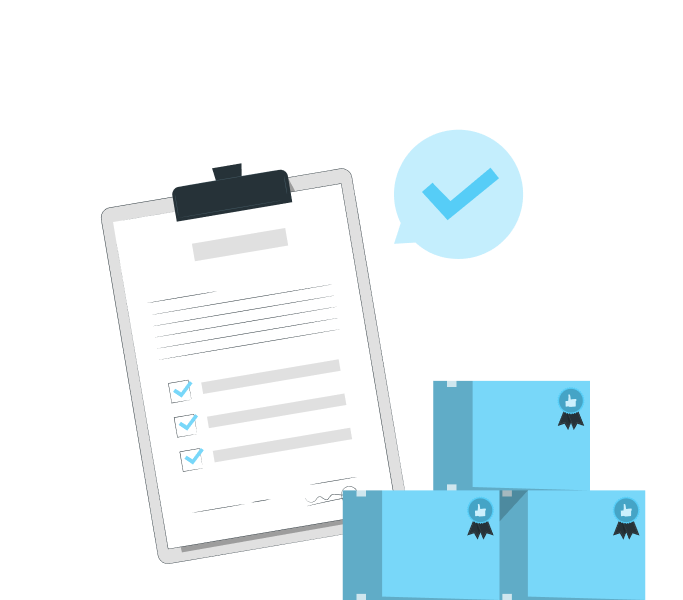Moving Checklist
Moving to a new house? Are you wondering what to do or worried about how to handle things without wasting much of your time? Just relax and continue reading our moving house checklist without stressing yourself with the thought of the strenuous task of relocating the house.
Download Create Customized Checklist2 months
before you move
6 weeks
before you move
4 weeks
before you move
3 weeks
before you move
2 weeks
before you move
1 week
before you move
1 day
before you move
Moving Day
Your First Day At Home
2 Months before your move
1. Create a file on google drive
On Google Drive, create a relocation file or folder to store receipts, moving quotes and other related records about your move. Such records may include how much a particular moving company is quoting you, the price charge of fifteen to twenty boxes. Store these in a document for easy reference as all these details can be easily forgotten over time.
2. Create a budget for expenses
Create a reasonable budget for relocation expenses. It is understandable that your wine fridge and that new sectional item require hiring a professional moving company, but you have to set your priorities straight. Setting a moving budget must be a high-priority task on your printable moving checklist as not having a set budget can cause you problems later.
3. Read documents
Be in knowing that before signing any documents, you need to read through them. Know about the documents you will be receiving before the moving day and make sure you don’t allow contracts to intimidate you. This is so important, and that is why we have it as a number on our list.
4. Take time off work for relocation day
Take time off work for relocation day. Plan to move and take off on Friday if possible. This is a very nice tip as you get to organize yourself for the rest of the weekend.
5. Locate and choose a school for your children
Locate and choose a school for your children. To get the best school in your area, agents can help you locate one. Just contact one for help.Furthermore, request for your kid's transcript from their old school to be used for their new school. The new school that your children will attend will need the transcript no matter the distance of your move. To avoid your kid(s) getting left behind, get prepared.
6. Organize a garage sale
Organize a garage sale and donate any of your belongings that you couldn’t sell.Unusual items such as fine art, pool tables or safes, pianos, and guns require extra moving plans as they are fragile. You may need to hire a specialty mover to move these items as the moving company you hire may not have the qualification required to move some larger and highly prized items. Ensure you understand to the fullest what your movers will not move to allow you to plan it out.
7. Verify the legitimacy of your moving company
Verify the legitimacy of your moving company with their Department of Transportation number, i.e., DOT number.
Create a Custom Moving Checklist To Be In Full Control Of Your Move

Tailor your checklist to your move (so you won’t be distracted by items that don’t matter to you)

Save a digital version or download your printable moving checklist

6 Weeks before you move
1. Make time for family and friends
Before moving day, make time for family and friends. You can throw a simple dinner party to catch the last memories of your current home. You don’t necessarily need an elaborate party to get this done.
Get free moving boxes from grocery, office supply, liquor stores, and restaurants. Your local bookstore is also not left out. They will be more than happy to hand over some boxes to you for free as they have more than required.
2. Make moving day stress-free
To make moving day stress-free, research packing hacks.Using different colored tapes/stickers for each room; label your moving boxes to make unpacking a lot easier when you get to your new home.
Before your highly prized items go on the moving truck, take inventory of it all. You can as well make a list of the boxes used to pack them. This is the right time to do this.
3. Avoid having textbooks
To avoid having textbooks stacked on top of your grandmother’s china, mark moving boxes that contain fragile items.Before unplugging, take photos of all electronics.
When you are reconnecting them at your new home, the images will help refresh your memory.For easy furniture reassembly, put all your hardware in labeled bags.Wrap your water glasses in dish towels, gather t-shirts, towels, socks, and linens to use as free packing supplies.
4. Find out if there are any moving day requirements
Find out if there are any moving day requirements if you are relocating into a new apartment.Before moving out, address minor home repairs.
This might help you in getting your security deposit back or not if you live in an apartment.Service your vehicle if you are moving across state lines to avoid a breakdown during the move. Do not leave jacks, spare tires and any other items in your car if your relocation requires shipping your car.
5. Make sure all the furniture will fit
To make sure all the furniture will fit, measure the elevators, stairways, and doorways twice.For places of interest such as a restaurant or new favorite hangout spot in your new community, conduct a little research on the area.
Yelp is the best place, to begin with.Lastly, pack a little day by day. Packing all your items the night before the move is not what you would want to do as there are a lot of things on your moving packing list that demands your attention.
4 Weeks before you Move
1. Cover all your possessions
To cover all your possessions during the move, purchase insurance coverage.You may need a parking permit for relocation day, be sure to confirm parking options for your truck.Items like bleach, aerosol cans, frozen foods and others that you can’t pack or sell are to be used or donated.Organize all legal and financial records in a single place.
2. Gather birth certificates
For everyone in your household, gather their birth certificates. Make sure important documents travel with you during the move.In your new area, find a snow removal service and landscaper.Return books to the library.Return both video game and movie rentals.Do not forget to pick up clothes from the dry cleaner
3. Compile and cross-check medical records
Dental, optical and medical records of everyone in your home are to be compiled and cross-checked.Find a new dentist, vet, and doctor in your new neighborhood if you are moving across the country.Update your voter registration information.Plan your route and book hotels if you are relocating to a long distance.
4. Schedule installation of internet
Schedule installation and/or cancel your old internet, phone and cable bundles.For your pets' collars, ensure they have ID tags.Get any necessary pet medication and request copies of vet recordsEnsure your pets have every vaccination if you are relocating out of the country.To have some fun while moving and unpacking your household, make a moving day playlist.
3 Weeks before you move
1. Gather jewelry
Gather jewelry, small family heirlooms, and valuable paperwork.
2. Keep jewelry separately from moving boxes
These special items are to be kept separately from your moving boxes and should be transported by hand or through a shipping service with insurance that offers a tracking system for your items.
3. Take photos of possessions
Take photos of any highly prized possessions and take note of any existing damage, dings, and scratches to your furniture.
2 Weeks before you move
1. Organize your moving-related receptions
To organize your moving-related receptions and bills, create a moving file. To claim a deduction at tax time, you will need to keep a list of moving expenses.Flammables, poisonous and corrosive items are to be recycled or disposed of and make sure you do this properly.
2. Use every food item
Use every food item you have in the freezer and prepare meals that will sustain you for two-weeks. You can check out some great meal preparation ideas on the internet.Return items you borrowed from family and friends.Back up your computer files, you will be glad you have everything saved in an alternative storage device if something should happen to your computer during your move.
3. Cancel your current service
Cancel your current service with trash removal and recycling and set up a new one for your new home.Remove light bulbs from all lamps you plan to take along with you.Clean out a safe deposit box and any lockers you might have at a community center or gym if you are moving to a long distance.Get and fill all your prescriptions from the pharmacy.
4. Prepare list of emergency
A list of emergency of preferred providers and service technicians should be prepared. Searching for plumbers online while your toilet is overflowing in your new home is not what you will like; so, prepare for it.Arrange for a play date or line up a babysitter for your little ones to keep them safe during your move.During your move, find somewhere safe for pets probably with a friend who would love to dog sit, or you look into doggy daycare to keep them temporarily.
5. Find your way to work
To find your way to work when you finally move, use public transportation or Google Maps.Send out moving announcements to family and friends and those who deserve to know. There are several creative ways to make your new address known to them.Update your new address with credit cards, payroll department at work, banks, and loan providers. Remember to order new checks as well.Forward your mail to your new address.
6. Change the address
Within 10 days of relocation, change the address for Social Security benefits. Inform the IRS, Department of Veterans Affairs, Social Security Administration and other government offices of the change in your address.Transfer your renters or homeowners from your current home to your new home.Cancel or transfer your membership at yoga studio, Cross–fit facility, gym, etc.For magazine and newspaper subscription, update your address if you have not done so.
7. Transfer Utilities
Utilities like electric, natural gas, water are to be transferred to your new home.Update your driver’s license to match your new address.For your car registration and auto insurance, change your address.Before moving your outdoor furniture, make sure you clean them.If necessary, transfer your medical prescriptions to a new pharmacy in your new neighborhood.
1 Week before your move
1. Dispose Chemicals
Chemicals, aerosol cans, paint, and other flammable items that cannot be transported are to be disposed of.Double-check the items you packed. Schedule a pickup by your chosen organization if you have more items to donate.Back up your computers to alternative storage.Make sure everyone in the family pack a suitcase containing comfortable clothes and toiletries for a two-week vacation-like move.
2. Contact your moving company
Be sure to contact your moving company to confirm details like cell phone numbers, moving-day arrival time, and any last-minute details.Schedule a day you will come back to the old house for final cleaning or hire a cleaning company to do a quick clean once the moving company leaves the premises.While you celebrate the memories you have made in your old home, get prepared to start a new phase in your life. This is so important.
3. Donate unopened food
Ask your movers if they work with Move for Hunger so you can donate unopened food.Ensure scheduled deliveries are redirected or canceled. Make sure your pending deliveries are sent to your new home address instead.Clean the old home for the incoming occupants.Unplug your freezer and fridge a night before the move to defrost. To absorb any water that leaks, ensure you lay a towel in front of it.
4. Drain water hoses
Drain water hoses to your ice maker and washing machine.Empty oil and gas from snow blowers, heaters, grills, and lawnmowers.If necessary, leave a note or small gift for the incoming residents.Ensure you check the shelves or closet corners for any hiding itemFill nail holes with a bar of soap before conducting a final walk through the house with your landlord.Prepare for rain or snow while you watch the weather channel.Pack every essential item you will need within the first day in your new home in a special box. Mark packing this box is a high-priority job in your moving packing list.
5. Make a plan for an unexpected scenario
Make a plan for an unexpected scenario such as movers running late.To prove your empty place is in move-out condition, take photographs of it.Embark on the move with enough cash to buy snacks and to tip your movers.In most cases, previous homeowners are only required to sweep their apartment or house, so clean your new place yourself to get the tip-top shape and sparkling look you so much like.
A Day before you Move
1. Packing a moving day box
Packing a moving day box that contains scissors, tape, paper towels, toilet paper, flashlights, bed linens, tools, light bulbs, and trash bags should also be considered.
2. Ensure you do not forget these essentials behind,
To ensure you do not forget these essentials behind, include them in the printable moving checklist in detail.Ensure you give your neighbors a notice about the move if you share a driveway with them or live in an HOA community. This will not only give them enough time to move their cars but also is the respectful thing to do.
3. Tip Movers
A nice gesture for a job well done is ‘tipping movers.’ Head to the ATM to withdraw cash for moving day if you plan to tip your movers.
Moving Day
1. Get up early
Get up early by setting the alarm.During the move, protect your carpets and floorsTip your movers; they have worked for you all day.
2. Make your bed
Make your bed and unpack toiletries and shower curtain as soon as your movers leave. This makes shower and nap much easier as they are probably the first thing you will want to do after the move.Meet your neighbors.
3. Go grocery shopping
You have probably eaten enough to take out, so go grocery shopping. You will be saved from unnecessary spending once you have food at home.To have privacy for your first night without curtains or shades yet, cover your windows with a sheet to sleep more comfortably.
4. Appreciate your broker
Appreciate your broker or real estate agent as they are the reason behind your move to this beautiful new home. Send them a simple thank you note.
Your First Day at Home
1. Double Check Your Utilities
As soon as you arrive, you should make sure your utilities are hooked up. Run the faucets, flush the toilet, try the lights - just do whatever you gotta do to make sure you’ve got the essentials connected. We don’t know how long your drive was, but you’ll probably want to take a shower eventually.
2. Connect Your Appliances
We recommend connecting your fridge as soon as possible, so it gets nice and cold by the time you do your first batch of grocery shopping. Aside from your refrigerator, you’ll want to connect your stove/oven, your dishwasher, and your washer/dryer. PS: This is a lot easier if you’ve paid your movers to do it for you.
3. Distribute Boxes
Think of what’s in each box, and place each box accordingly. Got a lot of office supplies? Put it in whatever room is going to be your office. Clothes and bedsheets? Into the bedroom with those. Remember when you made a staging area for all your boxes? This is the opposite approach.
4. Tip Your Movers
It’s been an emotional rollercoaster, but now it’s time to say your goodbyes to your moving team. If your movers did a good job, it’s customary to give them a tip. Like we said before, it’s usually 15% - 20% of the total cost of your move, to be divided across your whole moving team. Don’t forget the driver!
5. Meet Your Neighbors
There’s no better time to introduce yourself to the neighbors. Seriously, wait too long to do this, and everyone will wonder why you’re so standoffish. Say hi to your new neighbors, let them know who you are, and, if the vibe is alright, ask them if they have any recommendations for grocery shopping…
6. Do Some Shopping
Now that you’re on your own, it’s time to lock up for a minute and take care of some grocery shopping. Get familiar with your new grocery store, and get some much-needed supplies to keep you tided over until the next grocery run. And hey, grab a bottle of champagne to celebrate.
7. Make Your Bed
Decompress. Take that post-move shower. Enjoy a good meal. Make your bed, and fall into the best sleep of your life. You’re all moved in. From all of us at iMoving, congratulations!
Frequently Asked Questions
Absolutely not! Checklists are living documents, meant to help you sort out what it is that you need to get done and how you’re going to be able to work everything out.
If you need to make changes or additions, you are totally free to do so. Also, you can add things to the list that we’ve shared here so that it’s customized to your purposes.
Split tasks between you and your family members, and make it clear who has to do what. Also, as soon as you complete a task, mark it off. Take notes on your checklist if you need to do so, as well – it’ll help you to stay on task and be more efficient.
It’s all up to you. Some people just like to keep things as basic as they possibly can, but are capable of ensuring that everything in a particular sub-category is completed as it should be.
Other people feel much better when they’ve got a list that has every little thing listed on it. They feel like they won’t forget anything and they feel more accomplished as everything gets crossed off.
Utilizing a moving checklist is a great way to help keep yourself organized, but it is not the only item in your moving toolbox that can help you stay organized and efficient during this time.
You should also consider using helpful items like moving apps, where you can keep an itemized list of everything you need to pack on your phone and check it off as you go. You can further organize by color coding your moving boxes.
You can also make an itemized list showing you the contents of each box, which will eliminate the guesswork later when you are getting ready to unpack everything.
Getting rid of some of the things you don’t need or don’t use anymore is a great way to not only cut down on the amount of space you’re going to use in the moving truck, but it is also a great way to help you be that much more organized.
If you have things you want to sell, give away, or donate before the big move, consider getting in touch with friends who might be interested in the items you are trying to purge or using an online service like Facebook Marketplace to see who would be interested in them.
You could also donate your stuff to a local facility like Goodwill or the Salvation Army. If you want some extra cash in hand during the move, consider having a yard sale before moving day to offload as much of your unwanted items as possible for cash.
As moving day approaches the anxiety might come creeping up on you slowly, but don’t let it disorganize you. When you’re going through your things and packing up, take everything out of closets, boxes, and storage containers. Go through all of these belongings and decide what you want to keep and which things you might consider getting rid of.
It helps to see all of the items that you’re going through, so remove everything you can from their containers or boxes and put it in the center of the room to get a good idea of what you’re working with. From here, you can easily sort it out and decide what is staying and what is going.
The easiest way to answer this question is simply: Keep important things, and toss the things you don’t use anymore. Of course, it isn’t always that easy. This is why it is easier to go through all of your things several weeks or months before you move and start making plans on what you want to keep or purge then, while you still have plenty of time to decide.
Are there any dishes you no longer use? Have you read all of your books? Are there clothes you don’t wear anymore? Would you like to keep your current furniture or get new furniture when you reach your new destination? The answers to some of these simple questions can help you discover what you want to hang onto and what you wouldn’t mind getting rid of.
You should have everything packed up and loaded before moving day comes around. The day before moving, pack up an essentials bag and a small suitcase with some overnight clothes.
This is because you are not going to feel like unpacking everything the minute you reach your new home, so it will help to have your essentials with you in an easy to reach spot.
In your essentials bag, you should have things like your toothbrush, phone charger, wallet, any important documents, and toiletries.



